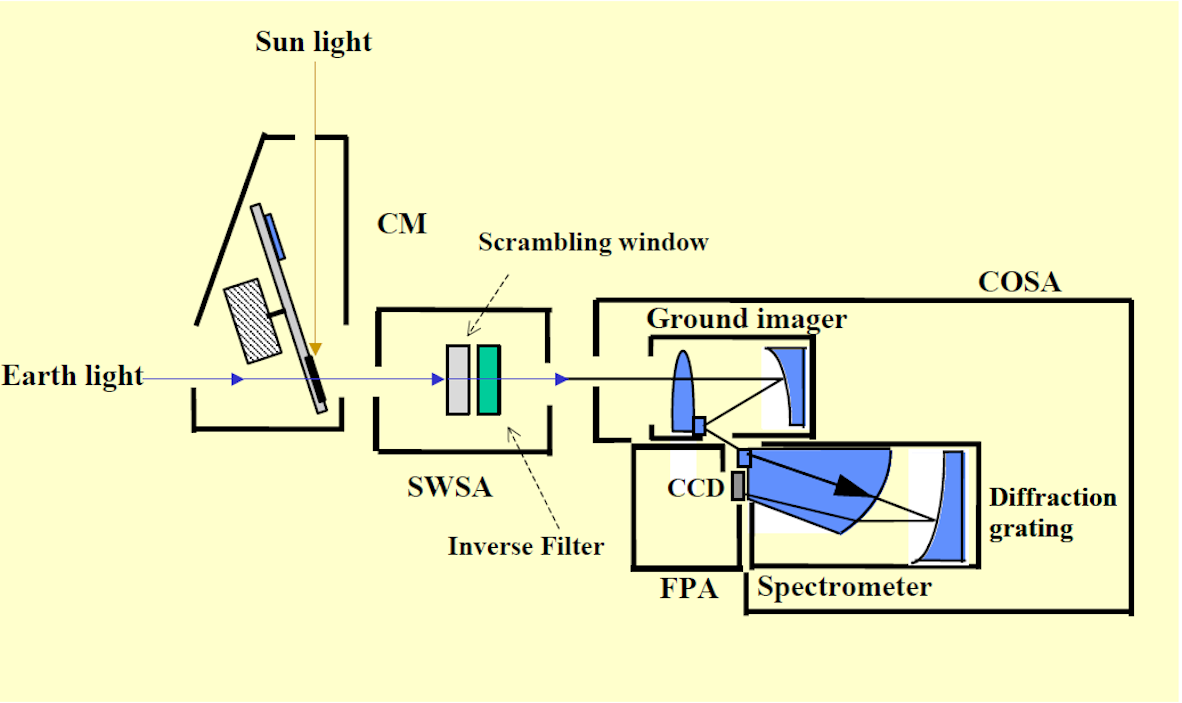Description - Sentinel-3 OLCI Technical Guide - Sentinel Online
The main OLCI structure, shown in the figure below, is composed of a base plate, supporting truss structure and a temperature controlled optical bench. An OLCI Electronics Unit (OEU) is mounted on the base plate and includes a power conditioning and distribution module, an instrument control module and a digital processing module responsible for real-time on-board processing of instrument measurement data. Heaters, radiators and heat pipe networks are configured in a similar way to MERIS providing separate thermal control to the electronics unit, the Video Acquisition Module (VAM) and Focal Plane Array (FPA). OLCI is located on top of the SENTINEL-3 satellite providing easy access to the sun (via the sun baffle assembly) during calibration views with minimum stray light. In this configuration, instrument radiators can be located away from the sun on the cold face of the spacecraft.
Radiance passes via a calibration assembly to one of five "cameras", each with a 14.1° Field of View (FOV), mounted in a fan arrangement on a common optical bench. The cameras are arranged to slightly overlap with each other to cover a wide 68.5° across track field of view. The OLCI swath is not centred at nadir (as in the MERIS design) but is tilted 12.6° westwards to mitigate the negative impact of sun glint contamination that affects almost half of the MERIS observations at sub-tropical latitudes. In addition, the OLCI instrument is mounted on the satellite to allow a direct view of the Earth, removing the need for the additional fold mirror used by MERIS.
 |
Legend
CM: Calibration Mechanism
SWSA: Scrambling Window Assembly
COSA: Camera Optics Sub-Assembly
CCD: Charged-Coupled Device
FPA: Focal Plane Assembly
Each OLCI camera includes a Scrambling Window Unit (SWU) mounted on the optical bench using a common support structure. The SWU forms the camera entrance pupil, includes a diaphragm structure to reduce stray light, reduces incoming radiance polarisation sensitivity (depending on the scene, the atmosphere and the illumination geometry), blocks UV radiance using a UV cut-off filter and optimises the incoming signal to the CCD response using an inverse filter.
The inverse filter has a high transmission in the blue and IR spectral region but attenuates the signal between these spectral limits. Radiance then passes to a Camera Optic Sub Assembly (COSA) that includes a ground imager and a spectrometer. The ground imager collects incoming radiance from the SWU and forms an image of the Earth in the plane of the spectrometer entrance slit. The spectrometer disperses the radiance using a concave grating and forms a dispersed image of the entrance slit on a CCD array mounted on an FPA. The resulting entrance slit image is bi-dimensional: one dimension corresponds to the spatial extension of the slit, and the other corresponds to the decomposition of radiance into spectral components from 390 nm to 1 040 nm.
The CCD assembly is derived from MERIS heritage and is actively cooled to an operating temperature of 251 K using a Peltier cooler. It operates with a sampling period of 44 ms that corresponds to approximately 300 m spatial ground resolution in the satellite flight direction. A VAM (one for each camera) then converts the output of the CCD into an analogue signal and passes 46 micro-bands (including the smeared data during frame transfer from the CCD) to the OEU for digital processing. Two imaging modes are possible: a raw mode used during instrument calibration when all 46 micro-bands are available (including all MERIS bands and those required to produce SPOT VEGETATION legacy products in synergy with SLSTR) and a nominal operating mode in which on-board spectral relaxation processing delivers 22 micro-bands (including one smear band) providing measurements with high absolute radiometric accuracy.